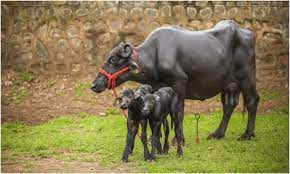Management of Summer Sub-Fertility in Buffaloes
Abstract: The buffalo holds significant importance in India’s dairy industry, serving as a vital asset for rural farmers. Known for their resilience to harsh conditions and ability to thrive on minimal inputs, buffaloes contribute substantially to milk, meat, manure, and draft power production. However, summer anoestrous, induced by heat stress, poses a challenge to buffalo fertility. Heat stress affects oestrus behaviour, cortisol secretion, and ovarian activity, leading to reduced estradiol levels and compromised reproductive functions. Additionally, heat stress impacts follicular development, embryonic survival, and early pregnancy, affecting artificial insemination success. Detecting oestrus in buffaloes requires diligent observation due to subtle signs, emphasising the need for tailored monitoring practices. Strategies like utilising teaser bulls aid in effective heat detection. Enhancing the genetic potential of buffaloes is imperative to meet the growing demand for milk production in India.
The buffalo forms the backbone of India’s dairy industry and is rightly considered as the ‘bearer cheque’ for rural farmers. These animals require a relatively low level of inputs in predominantly mixed farming systems and are well known for their ability to thrive on low-quality crop residues and green forage under harsh climatic conditions. Furthermore, the contributions of milk, meat and manure and draft power of the buffalo to the overall national economy have been overwhelming. So needless to add, buffalo is one of the most important livestock in India and its genetic potential for production and reproduction traits has to be improved to cater to the huge demand for milk production in our country.
Summer anoestrous is an important condition in buffaloes contributing to infertility in buffaloes. Heat stress has a pronounced effect on the oestrus behaviour of female animals as heat stress reduces the length and intensity of oestrus. Changes caused by heat stress reduce the likelihood of oestrus detection. Heat stress causes increased cortisol secretion and this hormone blocks estradiol-induced sexual behaviour. The effect of heat stress on oestrous behaviour also includes actions independent of the pituitary-adrenal axis reducing ovarian activity and follicular development. Heat stress causes a reduction in peripheral concentrations of estradiol at oestrus. Moreover, reduced physical activity is also probably an adaptive response that limits heat production and reduces oestrous behaviour.
Heat stress during the follicular growth period potentially compromises the oocyte, either because of direct actions of elevated temperature on the oocyte or because of alterations in the follicular function that will compromise the oocyte. Heat stress at the beginning of the day of ovulation reduces the diameter and volume of the dominant follicle of the oestrous cycle. Secretion of the hormones regulating reproductive tract function is also altered by heat stress. These changes lead to variable changes in steroid hormone concentrations in peripheral blood. This reduced action of steroid hormones on reproductive tract tissue during heat stress eventually impairs uterine and oviduct functions. The effect of heat stress on embryonic survival and development during the early stages of pregnancy is more pronounced as there is a decrease in embryo survival in the early stages of development due to heat stress. Disruption of early embryonic development results from actions on the embryo itself or on the oviducta or uterine environment in which the embryo resides.
Successful artificial insemination in buffaloes relies on timing the semen deposition during the oestrus or heat period when the female is sexually receptive. It’s recommended to observe animals twice daily, preferably in the early morning and late evening, for crucial oestrus signs. Notably, 60-70% of buffaloes exhibit heat between 6 pm to 6 am, emphasising the importance of monitoring during these times. Detecting oestrus in buffaloes is more challenging compared to cows due to their less intense oestrus behaviour. Unlike cows, buffaloes do not exhibit copious ropy hanging discharge; instead, the discharge is scanty and may go unnoticed by the owner. Signs of oestrus in buffaloes include a swollen reddish vulva, mounting behaviour (less frequent than in cows), and the standing reflex. Some buffaloes may not vocalise or exhibit silent heat, especially high-yielding ones. Restlessness, decreased feed intake, and raising the head in a typical manner are additional signs of oestrus in buffaloes. Teaser bulls, vasectomised bulls, can be used to parade in buffalo sheds to aid in heat detection.
| Sl.no | Characteristics | Value (Range) |
| 1 | Sexual season | Seasonally polyoestrous |
| 2 | Age at puberty (months) | 21(15-36) |
| 3 | Oestrus cycle length (Days) | 21 (18-22) |
| 4 | Oestrus signs duration (hrs | 21 (17-24) |
| 5 | Gestation length ( Days) | 310 (305-330) |
| 6 | Age at first calving (months) | 42 (36-56) |
| 7 | Calving intervals ( Months) | 18 (15-21) |
Causes of sub-fertility in buffaloes during summer include:
1) Excessive ambient temperature
2) Black body surface of animals
3) Presence of fewer sweat glands
4) Increased temperature affecting spermatogenesis in males and ovarian activity in females
5) Hampered activity of testosterone, progesterone, and estrogen during summer
6) Elevated temperature preventing corpus luteum regression, leading to continued progesterone release and inhibited LH release, resulting in anoestrus or sub-oestrus conditions
7) Reduced thyroid functioning during summer
Management of buffaloes in summer includes:
1) Protecting animals from direct sunlight during peak hours (11 am to 5 pm).
2) Providing access to wallowing tanks, sprinklers, or showering facilities to help them cool down. Alternatively, splash cold water on their bodies during the hottest part of the day.
3) Offering moist fodder to increase palatability.
4) Using teaser bulls for heat detection.
5) Replacing aged animals with younger ones as older animals may experience a loss of libido.
6) Supplementing fodder with vitamins and minerals to support overall health.
7) Grazing animals during cooler evenings if possible.
8) Applying Lugol’s iodine on the cervix of the animal, which acts as a local irritant stimulating the anterior pituitary to release gonadotropin, thereby aiding in the initiation of cyclicity.

Dr Ambika
Assistant Professor
Veterinary college Bidar
KVAFSU
Karnataka


